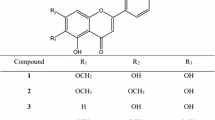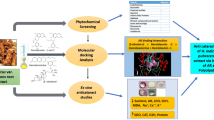Abstract
As part of our ongoing search of natural sources for therapeutic and preventive agents for diabetic complications, the rat lens aldose reductase (RLAR) inhibitory effect of Coptidis Rhizoma (the rhizome of Coptis chinensis Franch) was evaluated. Its extract and fractions exhibited broad and moderate RLAR inhibitory activities of 38.9∼67.5 μg/mL. In an attempt to identify bioactive components, six quaternary protoberberine-type alkaloids (berberine, palmatine, jateorrhizine, epiberberine, coptisine, and groenlandicine) and one quaternary aporphine-type alkaloid (magnoflorine) were isolated from the most active n-BuOH fraction, and the chemical structures therein were elucidated on the basis of spectroscopic evidence and comparison with published data. The anti-diabetic complications capacities of seven C. chinensis-derived alkaloids were evaluated via RLAR and human recombinant AR (HRAR) inhibitory assays. Although berberine and palmatine were previously reported as prime contributors to AR inhibition, these two major components exhibited no AR inhibitory effects at a higher concentration of 50 μg/ml in the present study. Conversely, epiberberine, coptisine, and groenlandicine exhibited moderate inhibitory effects with IC50 values of 100.1, 118.4, 140.1 μM for RLAR and 168.1, 187.3, 154.2 μM for HRAR. The results clearly indicated that the presence of the dioxymethylene group in the D ring and the oxidized form of the dioxymethylene group in the A ring were partly responsible for the AR inhibitory activities of protoberberine-type alkaloids. Therefore, Coptidis Rhizoma, and the alkaloids contained therein, would clearly have beneficial uses in the development of therapeutic and preventive agents for diabetic complications and diabetes mellitus.
Similar content being viewed by others
References
Cho, J. Y., Kim, A. R., and Park, M. H., Lignans from the rhizomes of Coptis japonica differentially act as anti-inflammatory principles. Planta Med., 67, 312–316 (2001).
de la Fuente, J. A., Manzanaro, S., Martín, M. J., de Quesada, T. G., Reymundo, I., Luengo, S. M., and Gago, F., Synthesis, activity, and molecular modeling studies of novel human aldose reductase inhibitors based on a marine natural product. J. Med. Chem., 46, 5208–5221 (2003).
Doggrell, S. A., Berberine-a novel approach to cholesterol lowering. Expert. Opin. Investig. Drugs., 14, 683–685 (2005).
El-Kabbani, O., and Podjarny, A., Selectivity determinants of the aldose and aldehyde reductase inhibitor-binding sites. Cell Mol. Life Sci., 64, 1970–1978 (2007).
Grycová, L., Dostál, J., and Marek, R., Quaternary protoberberine alkaloids. Phytochemistry., 68, 150–175 (2007).
Hayman, S. and Kinoshita, J. H., Isolation and properties of lens aldose reductase. J. Biol. Chem., 240, 877–882 (1965).
Hsieh, Y. S., Kuo, W. H., Lin, T. W., Chang, H. R., Lin, T. H., Chen, P. N., and Chu, S. C. Protective effects of berberine against low-density lipoprotein (LDL) oxidation and oxidized LDL-induced cytotoxicity on endothelial cells. J. Agric. Food Chem., 55, 10437–10445 (2007).
Huang, C., Zhang, Y., Gong, Z., Sheng, X., Li, Z., Zhang, W., and Qin, Y., Berberine inhibits 3T3-L1 adipocyte differentiation through the PPARgamma pathway. Biochem. Biophys. Res. Commun., 348, 571–578 (2006).
Huang, K. C. The pharmacology of Chinese herbs, CRC press Inc., Boca Raton: FL., pp. 381–382 (1999).
Hung, T. M., Lee, J. P., Min, B. S., Choi, J. S., Na, M., Zhang, X., Ngoc, T. M., Lee, I., and Bae, K., Magnoflorine from Coptidis Rhizoma protects high density lipoprotein during oxidant stress. Biol. Pharm. Bull., 30, 1157–1160 (2007)
Kawanishi, K., Ueda, H., and Moriyasu, M., Aldose reductase inhibitors from the nature. Curr. Med. Chem. 10, 1353–1374 (2003).
Ko, W. H., Yao, X. Q., Lau, C. W., Law, W. I., Chen, Z. Y., Kwok, W., Ho, K., and Huang, Y. Vasorelaxant and antiproliferative effects of berberine. Eur. J. Pharmacol., 399, 187–196 (2000).
Kong, W., Wei, J., Abidi, P., Lin, M., Inaba, S., Li, C., Wang, Y., Wang, Z., Si, S., Pan, H., Wang, S., Wu, J., Wang, Y., Li, Z., Liu, J., and Jiang, J. D., Berberine is a novel cholesterol-lowering drug working through a unique mechanism distinct from statins. Nat. Med., 10, 1344–1351 (2004).
Kuo, C. L., Chi, C. W., and Liu, T. Y. The anti-inflammatory potential of berberine in vitro and in vivo. Cancer Lett., 203, 127–137 (2004).
Lee, H. S., Rat lens aldose reductase inhibitory activities of Coptis japonica root-derived isoquinoline alkaloids. J. Agric. Food Chem., 50, 7013–7016 (2002).
Lee, H. Y. and Kim, C. W., Studies on the constituents of Berberis amurensis Ruprecht. Kor. J. Pharacogn., 28, 257–263 (1997).
Manzanaro, S., Salva, J., and de la Fuente, J. A., Phenolic marine natural products as aldose reductase inhibitors. J. Nat. Prod., 69, 1485–1487 (2006).
Mizuno, M., Kijima, H., Iinuma, M., Tanaka, T., and Goto, K., Coumarin derivatives in Coptis trifolia. Phytochemistry, 31, 717–719 (1992).
Nakai, N, Fujii, Y, Kobashi, K., and Nomura, K., Aldose reductase inhibitors: flavonoids, alkaloids, acetophenones, benzophenones, and spirohydantoins of chroman. Arch. Biochem. Biophys., 239, 491–496 (1985).
Nishimura, C., Yamaoka, T., Mizutani, M., Yamashita, K., Akera, T., and Tanimoto, T., Purification and characterization of the recombinant human aldose reductase expressed in baculovirus system. Biochim. Biophys. Acta., 1078, 171–178 (1991).
Racková, L, Májeková, M., Kost’álová, D., and Stefek, M. Antiradical and antioxidant activities of alkaloids isolated from Mahonia aquifolium. Structural aspects. Bioorg. Med. Chem., 12, 4709–4715 (2004).
Schinella, G. R., Tournier, H. A., Prieto, J. M., Mordujovich de Buschiazzo, P., and Ríos, J. L. Antioxidant activity of anti-inflammatory plant extracts. Life Sci., 70, 1023–1033 (2002).
Shirwaikar, A., Shirwaikar, A., Rajendran, K., and Punitha, I. S. In vitro antioxidant studies on the benzyl tetra isoquinoline alkaloid berberine. Biol. Pharm. Bull., 29, 1906–1910 (2006).
Sun, J., Ma, J. S., Jin, J., Wang, H. S., Wen, Q. H., Zhang, H. G., and Zhou, Q. L., Qualitative and quantitative determination of the main components of huanglianjiedu decoction by HPLC-UV/MS. Yao Xue Xue Bao., 41, 380–384 (2006).
Tang, L. Q., Wei, W., Chen, L. M., and Liu, S., Effects of berberine on diabetes induced by alloxan and a high-fat/ high-cholesterol diet in rats. J. Ethnopharmacol., 108, 109–115 (2006).
Tse, W. P., Che, C. T., Liu, K., and Lin, Z. X. Evaluation of the anti-proliferative properties of selected psoriasis-treating Chinese medicines on cultured HaCaT cells. J. Ethnopharmacol., 108,133–141 (2006).
Yahara, S., Satoshiro, M., Nishioka, I., Nagasawa, T., and Oura, H., Isolation and characterization of phenolic compounds from Coptidis Rhizoma. Chem. Pharm. Bull., 33, 527–531 (1985).
Yokozawa, T., Satoh, A., Cho, E. J., Kashiwada, Y., and Ikeshiro, Y., Protective role of Coptidis Rhizoma alkaloids against peroxynitrite-induced damage to renal tubular epithelial cells. J. Pharm. Pharmacol., 57, 367–374 (2005).
Yoshikawa, K., Kinoshita, H., Kan, Y., and Arihara, R., Neolignans and phenylpropanoids from the rhizomes of Coptis japonica var. dissecta. Chem. Pharm. Bull., 43, 578–581 (1995).
Yuan, L., Tu, D., Ye, X., and Wu, J., Hypoglycemic and hypocholesterolemic effects of Coptis chinensis franch inflorescence. Plant Foods Hum. Nutr., 61,139–144 (2006).
Author information
Authors and Affiliations
Corresponding author
Rights and permissions
About this article
Cite this article
Jung, H.A., Yoon, N.Y., Bae, H.J. et al. Inhibitory activities of the alkaloids from Coptidis Rhizoma against aldose reductase. Arch. Pharm. Res. 31, 1405–1412 (2008). https://doi.org/10.1007/s12272-001-2124-z
Received:
Revised:
Accepted:
Published:
Issue Date:
DOI: https://doi.org/10.1007/s12272-001-2124-z




